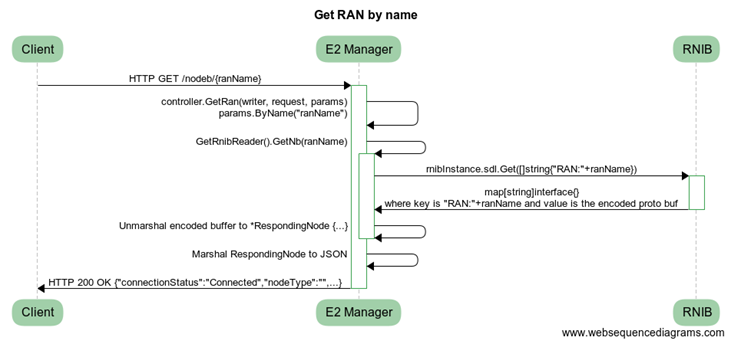1. Controller Layer
- Add Route:
GET("/v1/nodeb/:ranName", controller.GetNodeb) - Change name of requestController to nodebController:
controller := controllers.NewNodebController(logger, rmrService)
- New Controller method:
func (rc RequestController) GetNodeb (writer http.ResponseWriter, request *http.Request, params httprouter.Params)
- GetNb Business Logic
| Code | Comment |
|---|---|
ranName := params.ByName("ranName") | |
respondingNode, err := GetRnibReader().GetNodeb(ranName) | |
| OR |
m := jsonpb.Marshaler{} | |
result, err := m.MarshalToString(respondingNode) | Convert the unmarshalled proto to JSON. Handle error |
w.Header().Set("Content-Type", "application/json") | |
w.Write(result) | Respond with 200OK and responding node JSON representation. |
2. Entities
message RespondingNode{
ConnectionStatus connectionStatus = 1;
string ip = 2;
uint32 port = 3;
Node.Type nodeType = 4;
oneof Nodes{
ENB enb = 5;
GNB gnb = 6;
}
}
enum ConnectionStatus{
UNKNOWN_ConnectionStatus = 0;
Connected = 1;
NotConnected =2;
}
message Node{
enum Type {
UNKNOWN = 0;
ENB = 1;
GNB = 2;
}
}
3. RnibReader
- New package: rnibReade
RnibReader interface {
GetNb(key string) (*RespondingNode, error)
}
// Get may also create an instancefunc GetRnibReader() RnibReader {
return pool.Get().(RnibReader)
}
- Init RNIB instances pool (concern: separate the pool from rnibWriter layer)
- GetNodeb Business Logic
| Code | Comment |
|---|---|
| |
defer pool.Put(rnibInstance) | |
m, err := rnibInstance.sdl.Get([]string{ keyToCheck }) | USE SDL to fetch data from REDIS. RETURNS: (map[string]interface{}, error) |
data, ok := m[keyToCheck] | Get the value of the requested key. This will be a byte array |
pb := &RespondingNode{} | Create a new pointer to the responding node |
proto.Unmarshal(data, pb) | Unmarshal parses the protocol buffer representation in buf and places the decoded result in pb |
return pb |
